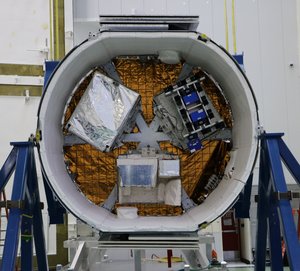

Terrestrial gamma-ray flash
Terrestrial gamma-ray flashes occur above some thunderstorms and propagate out into space. These high-energy discharges of photons were only discovered less than 25 years ago when a NASA spacecraft designed to observe cosmic gamma-ray bursts from outer space detected flashes that seemed to come from Earth itself.
The scientific community was intrigued, leading to the creation of an observatory to learn more that is now aboard the International Space Station. Called the Atmosphere-Space Interactions Monitor, or ASIM, the suite of instruments includes a gamma-ray detector mounted outside the European Columbus module that captures the whole visible part of Earth and can detect from where the gamma rays are coming.
Since the start of operations one year ago, the storm-hunter’s MXGS instrument has detected over 200 terrestrial gamma-ray flashes and, for nearly 30 of them, has pinpointed their location of origin. The image above shows the first-ever constructed image of a terrestrial gamma-ray flash based on data recorded on 18 June 2018.
The area of interest is on the right, which corresponds to a thunderstorm occurring over Borneo at the time. The more red-white the colour, the brighter the gamma-ray flux.
Thanks to these images scientists can now compare data with observations from other satellites and weather stations on the ground to piece together the sequence of events that cause the mysterious gamma-ray flashes.
The International Space Station offers ASIM the perfect platform to observe our planet in this way, as it flies relatively close to Earth at 400 km altitude and often travels over areas with thunderstorms.
Technical details:
Image energy range: 60-170 keV
Spectral shape of X-ray flux: We see a continuum spectrum which can be described by a power law with a spectral index of -1.9 in the energy range 50-400 keV. This is equivalent to the spectral index values found in the spectra of black holes and neutron stars. The terrestrial gamma-ray flash is a real hard gamma ray emitter.
Location: The ASIM detectors are pointing nadir (directly down at Earth). ASIM’s field of view for gamma-rays is the full Earth size, 137° by 137°. This means that the area displayed in the image is 1000 km x 1000 km at the coast of Borneo. The centre of the image corresponds to the Space Station’s position over Earth’s surface.
Image colour scale: The maximum of the probability distribution (the white area) is 7.8 (logarithmic scale) where the terrestrial gamma-ray flash is. The other blue and green spots are not significant: they have a probability value of 3.8 in the logarithmic scale. The probability difference between the maximum white area, where the terrestrial gamma-ray flash is, and the green spots is 10 000. So, a terrestrial gamma ray flash in the green areas is 10 000 times less probable.
We are changing our natural world faster than at any other time in history. Understanding the intricacies of how Earth works as a system and the impact that human activity is having on natural processes are huge environmental challenges. Satellites are vital for taking the pulse of our planet, delivering the information we need to understand and monitor our precious world, and for making decisions to safeguard our future. Earth observation data is also key to a myriad of practical applications to improve everyday life and to boost economies. This week we focus on the world’s biggest conference on Earth observation where thousands of scientists and data users discuss the latest results and look to the future of Earth observation.





